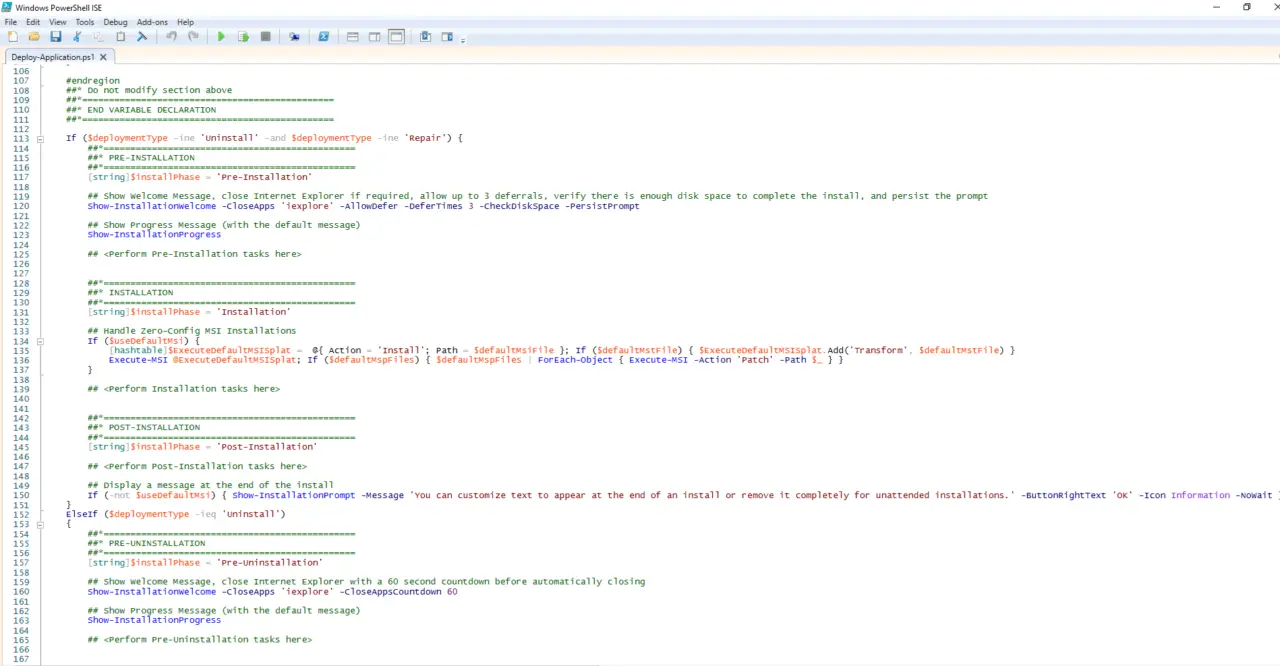
This article will serve as an informative guide and give you a clear understanding of how to perform silent or interactive installs and uninstalls of the Qwant Chrome Extension using the Powershell App Deployment Toolkit. The PowerShell App Deployment Toolkit can be used to replace your WiseScript, VBScript and Batch wrapper scripts with one versatile, re-usable and extensible tool. This tool is an absolute must for Microsoft Endpoint Manager Configuration Manager (MEMCM) / (SCCM) Administrators or anyone who is responsible for packaging and deploying software.
How to Install the Qwant Chrome Extension Using the PowerShell App Deployment Toolkit
- Download the Powershell App Deployment Toolkit 3.8.4:
- Download the zip file to a folder created at (C:\Downloads)
- Open Windows PowerShell by Right-Clicking on Windows PowerShell and selecting Run as Administrator
- Enter the following command to remove the Zone.Identifier:
Unblock-File -Path C:\Downloads\PSAppDeployToolkit_v3.8.4.zip
- Enter the following command to extract the contents of the zip file:
Expand-Archive -Path C:\Downloads\PSAppDeployToolkit_v3.8.4.zip -DestinationPath C:\Downloads\PADT
- Enter the following commands to copy the AppDeployToolkit & Files folders to “C:\Downloads\QwantCRX”:
Copy-Item -Path "C:\Downloads\PADT\Toolkit\AppDeployToolkit" -Destination "C:\Downloads\QwantCRX\AppDeployToolkit" -RecurseCopy-Item -Path "C:\Downloads\PADT\Toolkit\Files" -Destination "C:\Downloads\QwantCRX\Files"
You should now see the AppDeploymentToolkit folder with files & the empty Files folder at “C:\Downloads\QwantCRX”
- Open Notepad or your favorite text editor
- Add the following lines:
@ECHO OFF
SET NAME=HKLM\SOFTWARE\Policies\Google\Chrome\ExtensionInstallForcelist
SET VALUETOFIND=hnlkiofnhhoahaiimdicppgemmmomijo
SET VALUENAME=
REG QUERY "%NAME%" /f "%VALUETOFIND%"
IF %ERRORLEVEL% NEQ 0 GOTO END
FOR /f "tokens=1" %%a in ('REG QUERY %NAME% /f %VALUETOFIND% ^| FINDSTR REG_SZ') DO SET VALUENAME=%%a
REG DELETE "%NAME%" /v "%VALUENAME%" /f
:END- Save the file and name it: Remove-QwantCRX.bat
- Copy the Remove-QwantCRX.bat to “C:\Downloads\QwantCRX\Files\”
- Copy the PowerShell script below to “C:\Downloads\QwantCRX” & name it Deploy-QwantCRX.ps1
<#
.SYNOPSIS
This script performs the installation or uninstallation of the Qwant Chrome Extension.
# LICENSE #
PowerShell App Deployment Toolkit - Provides a set of functions to perform common application deployment tasks on Windows.
Copyright (C) 2017 - Sean Lillis, Dan Cunningham, Muhammad Mashwani, Aman Motazedian.
This program is free software: you can redistribute it and/or modify it under the terms of the GNU Lesser General Public License as published by the Free Software Foundation, either version 3 of the License, or any later version. This program is distributed in the hope that it will be useful, but WITHOUT ANY WARRANTY; without even the implied warranty of MERCHANTABILITY or FITNESS FOR A PARTICULAR PURPOSE. See the GNU General Public License for more details.
You should have received a copy of the GNU Lesser General Public License along with this program. If not, see <http://www.gnu.org/licenses/>.
.DESCRIPTION
The script is provided as a template to perform an install or uninstall of an application(s).
The script either performs an "Install" deployment type or an "Uninstall" deployment type.
The install deployment type is broken down into 3 main sections/phases: Pre-Install, Install, and Post-Install.
The script dot-sources the AppDeployToolkitMain.ps1 script which contains the logic and functions required to install or uninstall an application.
.PARAMETER DeploymentType
The type of deployment to perform. Default is: Install.
.PARAMETER DeployMode
Specifies whether the installation should be run in Interactive, Silent, or NonInteractive mode. Default is: Interactive. Options: Interactive = Shows dialogs, Silent = No dialogs, NonInteractive = Very silent, i.e. no blocking apps. NonInteractive mode is automatically set if it is detected that the process is not user interactive.
.PARAMETER AllowRebootPassThru
Allows the 3010 return code (requires restart) to be passed back to the parent process (e.g. SCCM) if detected from an installation. If 3010 is passed back to SCCM, a reboot prompt will be triggered.
.PARAMETER TerminalServerMode
Changes to "user install mode" and back to "user execute mode" for installing/uninstalling applications for Remote Destkop Session Hosts/Citrix servers.
.PARAMETER DisableLogging
Disables logging to file for the script. Default is: $false.
.EXAMPLE
PowerShell.exe .\Deploy-QwantCRX.ps1 -DeploymentType "Install" -DeployMode "NonInteractive"
.EXAMPLE
PowerShell.exe .\Deploy-QwantCRX.ps1 -DeploymentType "Install" -DeployMode "Silent"
.EXAMPLE
PowerShell.exe .\Deploy-QwantCRX.ps1 -DeploymentType "Install" -DeployMode "Interactive"
.EXAMPLE
PowerShell.exe .\Deploy-QwantCRX.ps1 -DeploymentType "Uninstall" -DeployMode "NonInteractive"
.EXAMPLE
PowerShell.exe .\Deploy-QwantCRX.ps1 -DeploymentType "Uninstall" -DeployMode "Silent"
.EXAMPLE
PowerShell.exe .\Deploy-QwantCRX.ps1 -DeploymentType "Uninstall" -DeployMode "Interactive"
.NOTES
Toolkit Exit Code Ranges:
60000 - 68999: Reserved for built-in exit codes in Deploy-Application.ps1, Deploy-Application.exe, and AppDeployToolkitMain.ps1
69000 - 69999: Recommended for user customized exit codes in Deploy-Application.ps1
70000 - 79999: Recommended for user customized exit codes in AppDeployToolkitExtensions.ps1
.LINK
http://psappdeploytoolkit.com
#>
[CmdletBinding()]
Param (
[Parameter(Mandatory=$false)]
[ValidateSet('Install','Uninstall','Repair')]
[string]$DeploymentType = 'Install',
[Parameter(Mandatory=$false)]
[ValidateSet('Interactive','Silent','NonInteractive')]
[string]$DeployMode = 'Interactive',
[Parameter(Mandatory=$false)]
[switch]$AllowRebootPassThru = $false,
[Parameter(Mandatory=$false)]
[switch]$TerminalServerMode = $false,
[Parameter(Mandatory=$false)]
[switch]$DisableLogging = $false
)
Try {
## Set the script execution policy for this process
Try { Set-ExecutionPolicy -ExecutionPolicy 'ByPass' -Scope 'Process' -Force -ErrorAction 'Stop' } Catch {}
##*===============================================
##* VARIABLE DECLARATION
##*===============================================
## Variables: Application
[string]$appVendor = ''
[string]$appName = 'Qwant Chrome Extension'
[string]$appVersion = ''
[string]$appArch = ''
[string]$appLang = ''
[string]$appRevision = ''
[string]$appScriptVersion = '1.0.0'
[string]$appScriptDate = 'XX/XX/20XX'
[string]$appScriptAuthor = 'Jason Bergner'
##*===============================================
## Variables: Install Titles (Only set here to override defaults set by the toolkit)
[string]$installName = ''
[string]$installTitle = 'Qwant Chrome Extension'
##* Do not modify section below
#region DoNotModify
## Variables: Exit Code
[int32]$mainExitCode = 0
## Variables: Script
[string]$deployAppScriptFriendlyName = 'Deploy Application'
[version]$deployAppScriptVersion = [version]'3.8.4'
[string]$deployAppScriptDate = '26/01/2021'
[hashtable]$deployAppScriptParameters = $psBoundParameters
## Variables: Environment
If (Test-Path -LiteralPath 'variable:HostInvocation') { $InvocationInfo = $HostInvocation } Else { $InvocationInfo = $MyInvocation }
[string]$scriptDirectory = Split-Path -Path $InvocationInfo.MyCommand.Definition -Parent
## Dot source the required App Deploy Toolkit Functions
Try {
[string]$moduleAppDeployToolkitMain = "$scriptDirectory\AppDeployToolkit\AppDeployToolkitMain.ps1"
If (-not (Test-Path -LiteralPath $moduleAppDeployToolkitMain -PathType 'Leaf')) { Throw "Module does not exist at the specified location [$moduleAppDeployToolkitMain]." }
If ($DisableLogging) { . $moduleAppDeployToolkitMain -DisableLogging } Else { . $moduleAppDeployToolkitMain }
}
Catch {
If ($mainExitCode -eq 0){ [int32]$mainExitCode = 60008 }
Write-Error -Message "Module [$moduleAppDeployToolkitMain] failed to load: `n$($_.Exception.Message)`n `n$($_.InvocationInfo.PositionMessage)" -ErrorAction 'Continue'
## Exit the script, returning the exit code to SCCM
If (Test-Path -LiteralPath 'variable:HostInvocation') { $script:ExitCode = $mainExitCode; Exit } Else { Exit $mainExitCode }
}
#endregion
##* Do not modify section above
##*===============================================
##* END VARIABLE DECLARATION
##*===============================================
If ($deploymentType -ine 'Uninstall' -and $deploymentType -ine 'Repair') {
##*===============================================
##* PRE-INSTALLATION
##*===============================================
[string]$installPhase = 'Pre-Installation'
## Show Welcome Message, Close Chrome With a 60 Second Countdown Before Automatically Closing
Show-InstallationWelcome -CloseApps 'chrome' -CloseAppsCountdown 60
## Show Progress Message (With a Message to Indicate the Chrome Extension that is Being Installed)
Show-InstallationProgress -StatusMessage "Installing the $installTitle. Please Wait..."
##*===============================================
##* INSTALLATION
##*===============================================
[string]$installPhase = 'Installation'
## Function to Enumerate Registry Values
Function Get-RegistryValues {
param(
[Parameter(Mandatory=$True)]
[string]$Path
)
Push-Location
Set-Location -Path $Path
Get-Item . | Select-Object -ExpandProperty property | ForEach-Object {
New-Object PSObject -Property @{"Property"=$_;"Value" = (Get-ItemProperty -Path . -Name $_).$_}
}
Pop-Location
}
## ExtensionInstallForcelist Registry Path
$RegistryPath = "HKLM:\SOFTWARE\Policies\Google\Chrome\ExtensionInstallForcelist"
$KeyType = "String"
## Qwant Extension
$ExtensionID = "hnlkiofnhhoahaiimdicppgemmmomijo;https://clients2.google.com/service/update2/crx"
## Create Registry Path If Not Present
If (!(Test-Path -Path $RegistryPath)) {
Write-Log -Message "Creating ExtensionInstallForcelist Registry Key."
Try {
New-Item -Path $RegistryPath -Force
}
Catch {
Write-Log -Message "Failed to Create ExtensionInstallForcelist Registry Key."
}
}
## Loop Through Existing Registry Properties & Values
$ExtensionProperties = Get-RegistryValues -Path $RegistryPath | Select-Object Property
$ExtensionValues = Get-RegistryValues -Path $RegistryPath | Select-Object Value
## Assume the List of Forced Extensions Will Never Exceed a Count of 50
$Values = 1..50
## No Registry Key Properties Found, Continue to Next Step
If ($ExtensionProperties -ne $null) {
## Find Next Available Number for Use in KeyName
$NextNumber = Compare-Object $ExtensionProperties.Property $Values | Select-Object -First 1
$KeyName = $NextNumber.InputObject
## Check if Qwant Chrome Extension is Already Installed
If ($ExtensionValues -match $ExtensionID) {
Write-Log -Message "The $ExtensionID Extension is Already Installed."
}
## Add the Qwant Chrome Extension
Else {
Write-Log -Message "The $ExtensionID Extension Was Not Found. Adding the Extension Now."
Try {
New-ItemProperty -Path $RegistryPath -Name $KeyName -PropertyType $KeyType -Value $ExtensionID
}
Catch {
Write-Log -Message "Failed to Add the $ExtensionID Extension."
}
}
}
## Add the Qwant Chrome Extension as the First Extension
Else {
Write-Log -Message "Adding the $ExtensionID Extension as the First Extension."
Try {
New-ItemProperty -Path $RegistryPath -Name 1 -PropertyType $KeyType -Value $ExtensionID
}
Catch {
Write-Log -Message "Failed to Add the $ExtensionID Extension as the First Extension."
}
}
##*===============================================
##* POST-INSTALLATION
##*===============================================
[string]$installPhase = 'Post-Installation'
}
ElseIf ($deploymentType -ieq 'Uninstall')
{
##*===============================================
##* PRE-UNINSTALLATION
##*===============================================
[string]$installPhase = 'Pre-Uninstallation'
## Show Welcome Message, Close Chrome With a 60 Second Countdown Before Automatically Closing
Show-InstallationWelcome -CloseApps 'chrome' -CloseAppsCountdown 60
## Show Progress Message (With a Message to Indicate the Chrome Extension that is Being Removed)
Show-InstallationProgress -StatusMessage "Removing the $installTitle. Please Wait..."
##*===============================================
##* UNINSTALLATION
##*===============================================
[string]$installPhase = 'Uninstallation'
## Remove Qwant Chrome Extension from ExtensionInstallForcelist
C:\WINDOWS\System32\cmd /c $dirFiles\Remove-QwantCRX.bat
##*===============================================
##* POST-UNINSTALLATION
##*===============================================
[string]$installPhase = 'Post-Uninstallation'
}
ElseIf ($deploymentType -ieq 'Repair')
{
##*===============================================
##* PRE-REPAIR
##*===============================================
[string]$installPhase = 'Pre-Repair'
##*===============================================
##* REPAIR
##*===============================================
[string]$installPhase = 'Repair'
##*===============================================
##* POST-REPAIR
##*===============================================
[string]$installPhase = 'Post-Repair'
}
##*===============================================
##* END SCRIPT BODY
##*===============================================
## Call the Exit-Script function to perform final cleanup operations
Exit-Script -ExitCode $mainExitCode
}
Catch {
[int32]$mainExitCode = 60001
[string]$mainErrorMessage = "$(Resolve-Error)"
Write-Log -Message $mainErrorMessage -Severity 3 -Source $deployAppScriptFriendlyName
Show-DialogBox -Text $mainErrorMessage -Icon 'Stop'
Exit-Script -ExitCode $mainExitCode
}
Ok, all the hard work is done and now you can install or uninstall the Qwant Chrome Extension using one single PowerShell script. Simply change the DeploymentType parameter to install or uninstall. Logging functionality is built-in automatically and you can view the log files under “C:\Windows\Logs\Software”.
Qwant Chrome Extension NonInteractive Install (PowerShell)
NonInteractive means Very Silent, i.e. no blocking apps. This is automatically set if it is detected that the process is not running in the user session and it is not possible for anyone to provide input using a mouse or keyboard.
- Open Windows PowerShell by Right-Clicking on Windows PowerShell and selecting Run as Administrator
-
Change the directory to “C:\Downloads\QwantCRX”
- PS C:\Downloads\QwantCRX>
- Enter the following command:
Powershell.exe -ExecutionPolicy Bypass .\Deploy-QwantCRX.ps1 -DeploymentType "Install" -DeployMode "NonInteractive"
Qwant Chrome Extension Silent Install (PowerShell)
Silent means no dialogs (progress and balloon tip notifications are suppressed).
- Open Windows PowerShell by Right-Clicking on Windows PowerShell and selecting Run as Administrator
-
Change the directory to “C:\Downloads\QwantCRX“
- PS C:\Downloads\QwantCRX>
- Enter the following command:
Powershell.exe -ExecutionPolicy Bypass .\Deploy-QwantCRX.ps1 -DeploymentType "Install" -DeployMode "Silent"
Qwant Chrome Extension Interactive Install (PowerShell)
Interactive means the install will show dialogs including progress and balloon tip notifications.
- Open Windows PowerShell by Right-Clicking on Windows PowerShell and selecting Run as Administrator
-
Change the directory to “C:\Downloads\QwantCRX”
- PS C:\Downloads\QwantCRX>
- Enter the following command:
Powershell.exe -ExecutionPolicy Bypass .\Deploy-QwantCRX.ps1 -DeploymentType "Install" -DeployMode "Interactive"
How to Uninstall the Qwant Chrome Extension Using the PowerShell App Deployment Toolkit
Qwant Chrome Extension NonInteractive Uninstall (PowerShell)
NonInteractive means Very Silent, i.e. no blocking apps. This is automatically set if it is detected that the process is not running in the user session and it is not possible for anyone to provide input using a mouse or keyboard.
- Open Windows PowerShell by Right-Clicking on Windows PowerShell and selecting Run as Administrator
-
Change the directory to “C:\Downloads\QwantCRX“
- PS C:\Downloads\QwantCRX>
- Enter the following command:
Powershell.exe -ExecutionPolicy Bypass .\Deploy-QwantCRX.ps1 -DeploymentType "Uninstall" -DeployMode "NonInteractive"
Qwant Chrome Extension Silent Uninstall (PowerShell)
Silent means no dialogs (progress and balloon tip notifications are suppressed).
- Open Windows PowerShell by Right-Clicking on Windows PowerShell and selecting Run as Administrator
-
Change the directory to “C:\Downloads\QwantCRX“
- PS C:\Downloads\QwantCRX>
- Enter the following command:
Powershell.exe -ExecutionPolicy Bypass .\Deploy-QwantCRX.ps1 -DeploymentType "Uninstall" -DeployMode "Silent"
Qwant Chrome Extension Interactive Uninstall (PowerShell)
Interactive means the install will show dialogs including progress and balloon tip notifications.
- Open Windows PowerShell by Right-Clicking on Windows PowerShell and selecting Run as Administrator
-
Change the directory to “C:\Downloads\QwantCRX“
- PS C:\Downloads\QwantCRX>
- Enter the following command:
Powershell.exe -ExecutionPolicy Bypass .\Deploy-QwantCRX.ps1 -DeploymentType "Uninstall" -DeployMode "Interactive"
Always make sure to test everything in a development environment prior to implementing anything into production. The information in this article is provided “As Is” without warranty of any kind.

